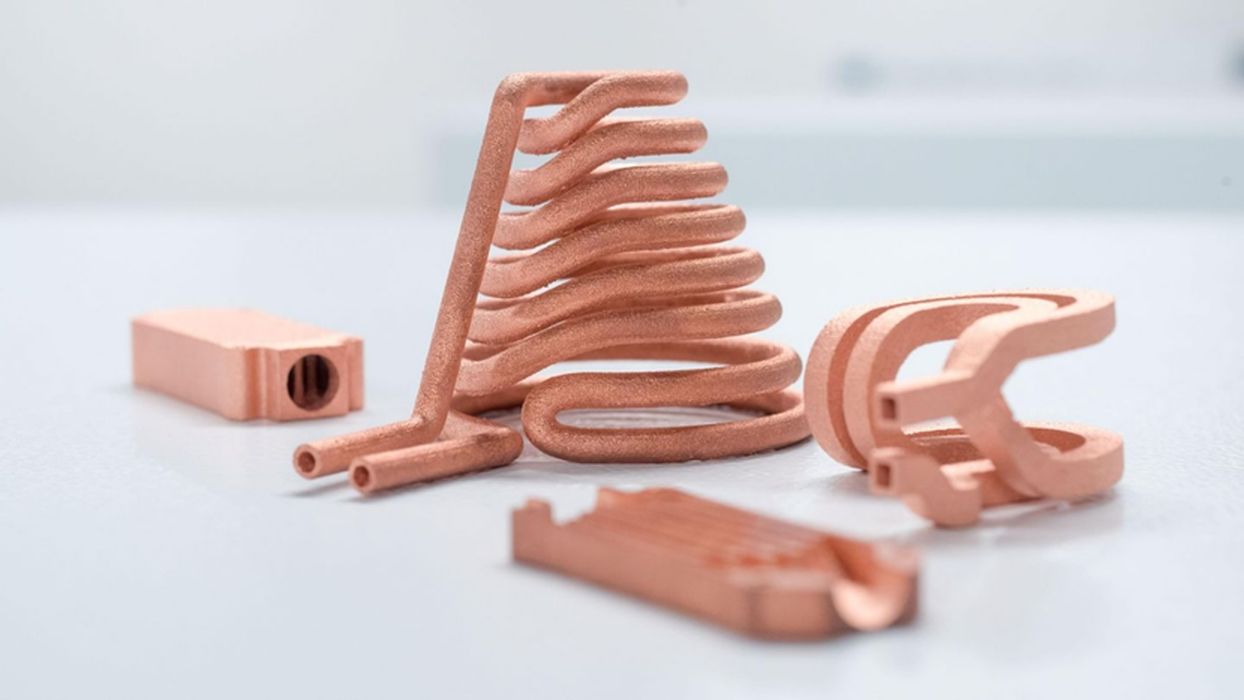
Charles Goulding and Mwansa Chabala look at the potential of copper in future additive manufacturing operations.
Copper is a highly conductive and malleable metal that has excellent properties for electrical and thermal conductivity, making it an ideal material for various technological applications. It is widely used in the production of electronic devices, such as smartphones, tablets, and computers, as well as in electric vehicles, renewable energy technologies, and infrastructure development.
The expanding global demand for these technologies has resulted in an increase in copper mining, with countries such as Chile, Peru, and Zambia being major producers of the metal. As the world continues to transition towards a more digital and sustainable future, the demand for copper is expected to remain strong, driving further exploration and development of copper mines around the world.
3D Printing Copper

The first 3D printing metal process on record was in 1997 by AeroMat. They used Laser Additive Manufacturing (LAM), which uses high powered lasers to fuse powdered metal. The metal produced using this method was found to have weaker properties and deformations due to the nature of the metal properties such as reflection and conductivity, that gave it a tendency to absorb the laser.
Since then, the industry has evolved to come up with more solutions to overcome this problem such as powder bed fusion. In our October, 2020 Fabbaloo article, we discussed the relevance of 3D printing copper in the industrial world, as well as how various challenges were overcome to make it possible.
The progress in 3D printing copper has been remarkable. Today, 3D printed copper is used in space travel, with 3D printed copper propulsion systems sending rockets into space. Copper heatsinks keep CPUs cool, and copper coils boost electric motor performance.
3D printing also opens up more possibilities and applications for the metal, as it enables the production of complex shapes, fine details, internal structures, and lattice infills not possible with any other type of metal manufacturing. This can reduce weight, increase efficiency, and reduce manufacturing and assembly time, as multi-part assemblies can be 3D printed as a single unit.
Furthermore, 3D printing is more efficient in terms of manufacturing, reducing waste by using only the amount of material necessary for each part. For companies interested in 3D copper printing, this reduction in raw material costs is critical.
AI and Copper Production: The Mingomba Project
The rise in demand for copper has increased the urgency to source the metal in various locations. One such potential source is Zambia; a country in the heart of Southern Africa.
Zambia is one of the leading producers of copper, ranked eigth in the world and second in Africa. Home to the largest underground mine in Africa, Zambia’s economy has been strongly rooted in the production of copper, comprising 77 percent of its annual export value and 27.7 percent of annual government revenue. In 2021, the country produced 830,000MT of copper. It houses operations of other global mining giants such as Barrick Gold, Glencore and Vedanta.
A new venture has been initiated in the country that could see a huge leap in the way mining is done loccally. KoBold Metals, an exploration firm based in California, is investing US$150M in the development of a copper-cobalt mine in Zambia. The project site is in a town called Mingomba, located on the Copperbelt Province, Zambia. The project is attempting to use artificial intelligence to mine the metals.
KoBold has had some other noteworthy explorations, including some in Quebec, Saskatchewan, Ontario, and Western Australia. Their sights have now been set on the Mingomba project, as the area is said to contain about 247MT of ore at an average 3.64% grade, six times higher than that of the copper produced by Chile (the world’s largest producer of copper).
Using AI in the mining industry could significantly increase efficiency in the industry. It can be used to analyze geological data such as mineral content and ore quality, as well as environmental data that affects the mining operations such as air and water quality. It can also be used for automated mining to optimize the mining equipment, thus increasing productivity, reducing costs and minimizing risks.
The Research and Development Tax Credit
The now permanent Research and Development (R&D) Tax Credit is available for companies developing new or improved products, processes and/or software.
3D printing can help boost a company’s R&D Tax Credits. Wages for technical employees creating, testing, and revising 3D printed prototypes can be included as a percentage of eligible time spent for the R&D Tax Credit. Similarly, when used as a method of improving a process, time spent integrating 3D printing hardware and software counts as an eligible activity. Lastly, when used for modeling and preproduction, the costs of filaments consumed during the development process may also be recovered.
Whether it is used for creating and testing prototypes or for final production, 3D printing is a great indicator that R&D Credit eligible activities are taking place. Companies implementing this technology at any point should consider taking advantage of R&D Tax Credits
Conclusion
3D printing and artificial intelligence are just a few among many technologies that are opening new possibilities for the copper production industry, and mining in general. With 3D printing technology, more intricate copper parts can be produced faster, with increased speed and efficiency. The integration of AI algorithms in the production process can equally see an exponential increase in efficiency, productivity, and quality control. Both processes give positive indications of growth in the mining and manufacturing industry.
